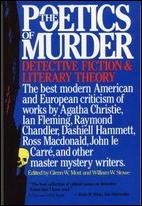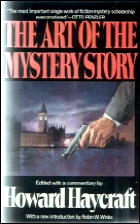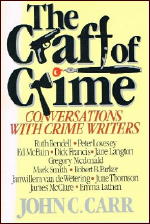Fri 12 Apr 2013
[Archived] NOTES ON RECENT READING: About the Mystery, by Marvin Lachman.
Posted by Steve under Reference works / Biographies , Reviews[5] Comments
by Marvin Lachman.

I really wanted to like THE POETICS OF MURDER (1983), edited by Glenn W. Most and William W. Stowe, an Edgar-nominated collection of essays from Harcourt, Brace Jovanovich in hardcover and trade paperback. Good writing about mystery is always in short supply. Unfortunately, this is an anthology of pretentious essays, written from an academic viewpoint, and boring as hell.
One essay argues that the “…intense curiosity aroused by the detective story derives from its association with the primal scene, a psychoanalytic term reference to a child’s first observation, either real or imagined, of sexual intercourse between his or her parents.” Other essays deal wih “The Detective Novel and Its Social Mission;” “Delay and the Hermenautic Sentence;” “From Semiotics to Heremneutics: Modes of Detection in Doyle and Chandler;” “Metaphysical Detective Stories in Postwar Fiction.”
An East German writer, Ernst Kaemmel, claims that the detective story is the child of capitalism, its crimes involve attacks on private property. He celebrates the absence of detective stories in Socialist countries but has missed the main reason. It is that the idea of finding truth, so essential to the detedcteive story as we know it, was not accepted in Nazi Germany, nor currently in East Germany or the USSR.
Professor David Grossvogel, reasoning along similar lines, finds the detective story bad because, by providing fictional mysteries to solve, it distracts readers from the real mysteries (and problems) of life. I wonder what, if anything, Professor Grossvogel does for escape.
In POETICS OF MURDER mysteries are repeatedly compared to “literature.” Opinions are tossed off, as if sacred, with no explanation, e,g., “Certain works are easily rejected, however. I have trouble reading Edgar Wallace and Ellery Queen, though I have tried several times.” Almost every article has a publish or perish quality to it, with never a feel for the fun in reading the mystery.

Now, if you want a really good book of essays about mystery fiction, pick Howard Haycraft’s classic THE ART OF THE MYSTERY STORY (1946), just reprinted in trade paperback by Carroll & Graf. The editor and his contributors are just as erudite and insightful, but they have written for people who read and love mysteries, and the differences show both in quality and variety.
We have serious but non-pedantic, pieces by Chesterton, Chandler, Knox, Gardner, Sandoe, Carr, and many others. There’s also humor, including Rex Stout poking his tongue in his cheek to prove that Watson was a woman. We have Edmund Wilson deriding the form, “Who Cares Who Killed Roger Ackroyd” and its proponents, writers like Nicholas Blake, Anthony Boucher, and Joseph Wood Krutch, giving a different viewpoint.
There are lists of great books, classic introductions by Sayers and Van Dine, reviews by Dashiell Hammett, etc. If ever an anthology deserved to be called “great,” THE ART OF THE MYSTERY STORY does.

However, one need not go back to 1946 to find a good book about the mystery. A fine recent book is THE CRAFT OF CRIME (1983) by John C. Carr from Houghton, Mifflin in hardcover. Carr provides interviews with twelve of the most popular mystery writers around and by adroit questioning and selection of articulae subjects, he has given us an interesting book which also increases our knowledge of the field.
The writers selected are Kendell, Lovesey, McBain, Francis,Langton, Gregory Mcdonald, Mark Smith, Robert B. Parker, Van de Watering, June Thomson, McClure, and Lathen. Mr. Carr is a good questioner with only occasional lapses when he is in too obvious awe of his subject. Otherwise, the Q and A technique works quite well, with the exception of a bias against William Faulkner which Carr betrays in several questions.
Most of the time we get probing questions which permit these writers to demonstrate how interesting and witty they are. There are differences in quality as is inevitable in a collection of this type, but not a bad interview in the lot. My favorites are those with Parker and the two women who write as as Emma Lathen.
Parker has some trenchant things to say about academic life which he was able to leave in 1979 for full-time writing. His description of his priorities in life make us feel as if we really know him, though I’m not sure about liking him. Parker provides a neat summary of the difference between old-style mysteries and the kind he writes, claiming that the world is “no longer amenable to logical deduction.”
He’s probably right in that regard, but he misses the point that it is exactly for that reason that many of us look for escape reading in which intellect does triumph. As long as writers write (and the public buys) mysteries like Parker’s which are often resolved by fist fights or gun battles, rather than by brains, we shall have a case of a self-fulfilling prophecy.
April 12th, 2013 at 5:06 pm
One of those typical lefty-testicle-free blabla books, I surmise ?
The Doc
April 12th, 2013 at 5:17 pm
Maybe the first one, Doc, though those aren’t exactly the words I’d use, but not the second two — most definitely not.
April 12th, 2013 at 6:05 pm
Use the words, Steve- good english is clear english.
The Doc
April 12th, 2013 at 10:24 pm
I’ve been thinking about what Marv had to say about the Parker interview in the Carr book. Parker’s career started in the mid-1970s, and while the break wasn’t sudden and immediate, I’d have to say that the mid-1970s was when the emphasis in crime and mystery fiction really switched from detective stories to action and thriller novels, which except for the frothiest of cozies, is almost all that you can find to read today.
Not that Parker was the cause, but he seems to have seen the ride was coming and he just went along with it.
April 13th, 2013 at 4:01 am
Not all essays in POETICS OF MURDER are as bad as the examples Marvin Lachman has selected. Some contributors even love the stories they are writing about, for example Fredric Jameson. By the way, someone is able to analyse a subject correctly without loving it. Finally I would like to refer to CRIME IN GOOD COMPANY (1959), edited by Michael Gilbert, as a further alternative.